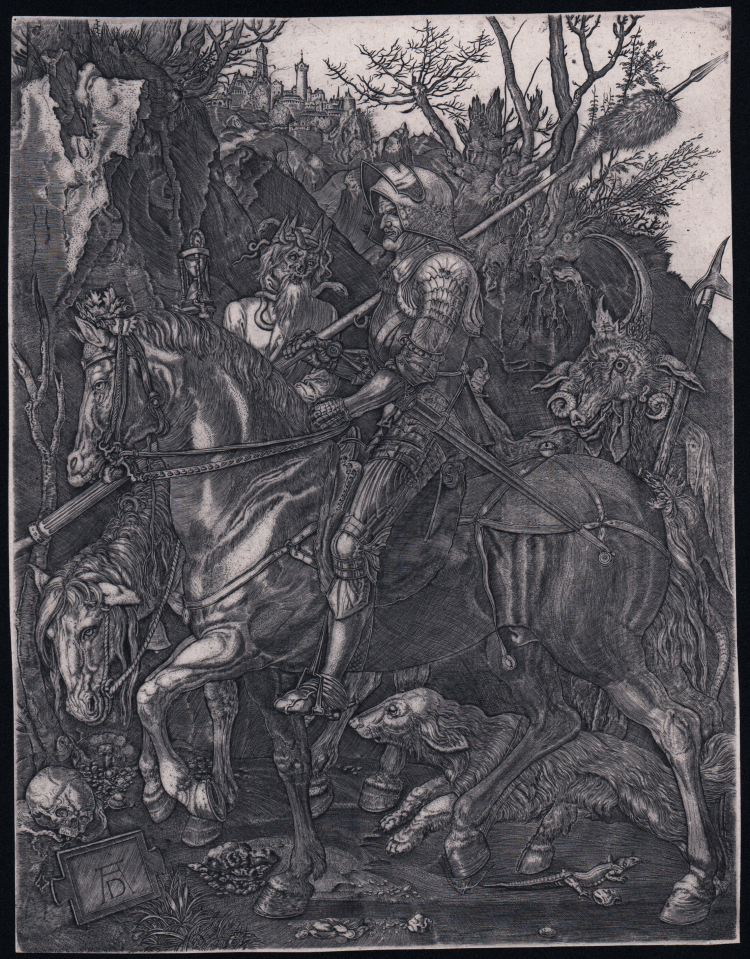



| Reference: | S41421 |
| Author | Anonimo |
| Year: | 1540 ca. |
| Measures: | 134 x 238 mm |


| Reference: | S41421 |
| Author | Anonimo |
| Year: | 1540 ca. |
| Measures: | 134 x 238 mm |
Engraving, post 1513, signed with Durer’s monogram on the tablet at lower left.
Copy after Dürer. The S and the date 1515 are missing from the tablet. A fine impression, printed on contemporary laid paper, trimmed to the platemark, very good condition.
This famous engraving is part of an ideal triptych of engravings called "Meisterstiche" (Master Engravings), similar in size and subject matter, although profoundly different from each other. This triptych includes - in addition to the present "The Knight, Death and the Devil" - the "Saint Jerome" and "Melancholia". Although various theories have been advanced, there is no evidence that Dürer himself regarded the three 'Meisterstiche' as a set - the diary of his journey to the Netherlands shows that he gave them away separately rather than together, or paired 'St Jerome' with the 'Melancholia' but without the 'Knight'.
Yet they form a spiritual unity in that they symbolize three ways of life which correspond, as Friedrich Lippmann pointed out to the scholas tic classification of the virtues as moral, theological and intellectual. The Knight, Death and Devil typifies the life of the Christian in the practical world of decision and action; the St. Jerome the life of the Saint in the spiritual world of sacred contemplation; and the Melencolia I the life of the secular genius in the rational and imaginative worlds of science and art.
Giorgio Vasari interpreted the central figure as representing ‘Human Strength’, and commented on the ‘lustre of the arms and of the black horse’s coat’. In the nineteenth century it was suggested that the print is an illustration of Erasmus’s influential text, the 'Handbook of a Christian Knight', published in 1503, which urged Christians to act as soldiers, combating temptation and malevolence with faith. The print also evokes the 23rd Psalm: ‘though I walk through the shadow of the valley of death, I will fear no evil’ (Psalms 23:4).
Dürer's awareness of the fact that the first of these three prints, the Knight, Death and Devil, was an important enterprise is again manifested by the special form of the signature. The figure 1513 is preceded by an "S.," an abbreviation of the word Salus which occurs, identically placed in the date lines of Dürer's first drafts for an Introduction to his Treatise on Human Proportions, composed in 1512 and 1513. In the Diary of his journey to the Netherlands Dürer refers to the engraving simply as the " Reuter " (the Horseman).
This virtuoso engraving by Dürer shows a lone knight riding through an oppressive landscape. A dog runs at his horse’s feet, and Death holds aloft an hourglass while the Devil stalks behind. Although the meaning of this print has not been satisfactorily explained, it is clear that the message is an ominous one. A skull, a reminder of death, lies on a tree trunk in the left foreground, and a lizard, sometimes seen as a harbinger of danger, scuttles to the right. The figures in the foreground are enclosed by the rocky landscape and the brittle, dead trees. A city seen atop a mountain in the distance further serves to emphasise the knight’s isolation from society.
|
Bartsch, 98a; TIB, 1001.098, C1; Dodgson, Albrecht Dürer (70).
|
Anonimo
|
Bartsch, 98a; TIB, 1001.098, C1; Dodgson, Albrecht Dürer (70).
|
Anonimo